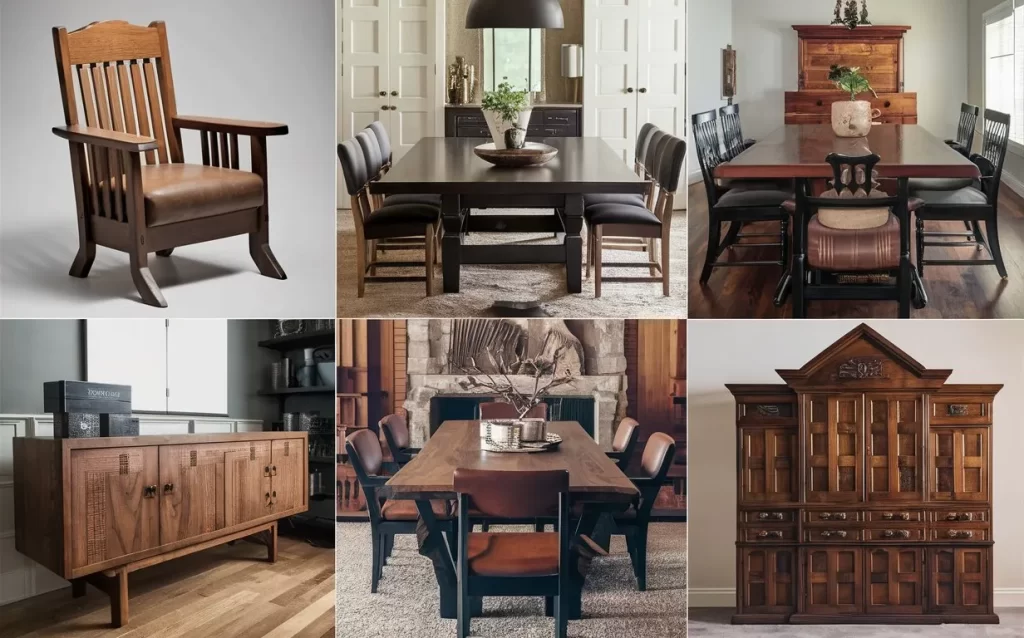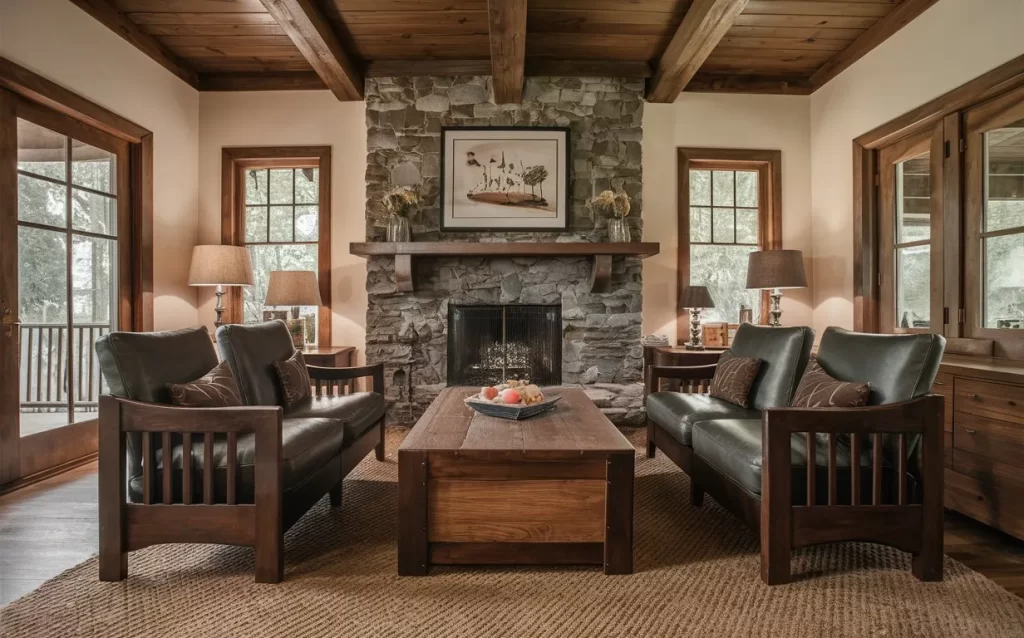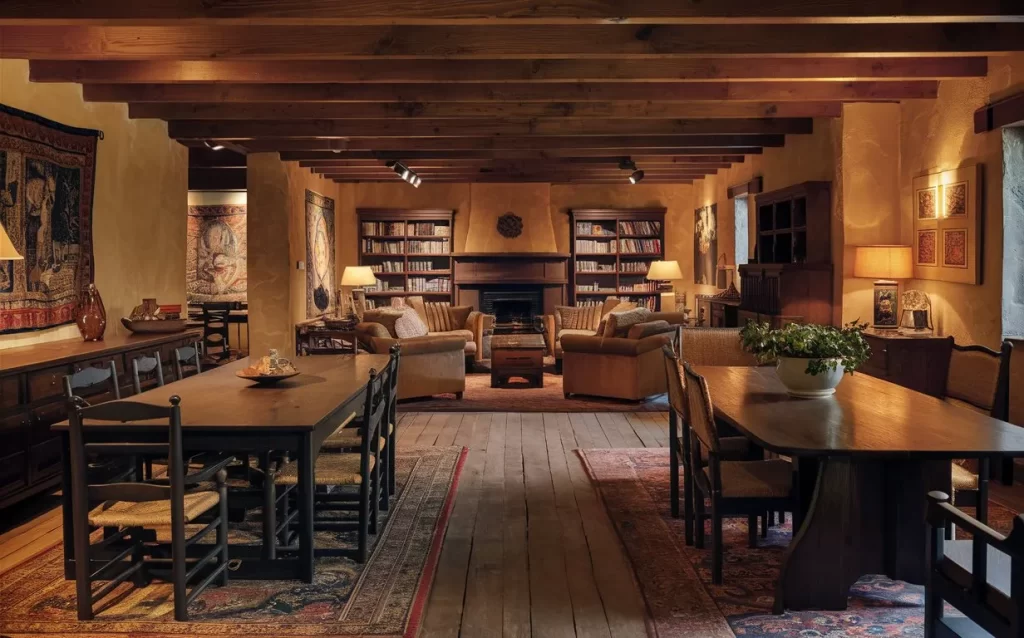Table of Contents
Mission-style furniture is more than just a design trend; it’s a timeless piece that has left an indelible mark on interior decor. The word characteristics of Mission furniture focus on Mission furniture, which is often made from solid wood, which helps to accentuate the grain and enhance its natural beauty. Mission Furniture and Stickley’s furniture share many of the same design principles that highlight craftsmanship—handcrafted details. Mission Style Furniture Period History highlights the contributions of notable furniture designers like Gustav Stickley. is a craftsmanship, simplicity, and solid wood furniture, especially those designed in the arts and crafts style and elegance story. The history, characteristics, and enduring impact of Mission-style furniture will all be covered in this article. If you’re curious about the latest updates in interior design and how this classic style continues to captivate enthusiasts, read on.
Mission-Style Furniture History: The Inception of Mission-Style Furniture
Origins of Mission Style Furniture
The Mission Style Furniture Period History begins in the late 19th century, influenced by the American Arts and Crafts Movement. This furniture style was born from the desire to break free from mass-produced furniture. The Industrial Revolution played a significant role in the development of Mission-style furniture, which began to flourish around 1901—influences, promoting craftsman style and solid wood construction. Gustav Stickley, a prominent furniture maker, revolutionized the industry and shaped this style. Inspired by Spanish missions’ simple, functional furniture style, this design emphasizes horizontal and vertical lines. Wood furniture was used in Spanish missions in California; Mission furniture was designed with clean lines, often made from white oak or mission oak. It offered a refreshing alternative to the ornate, often over-complicated designs of the Victorian era.
Key Influences on Mission Style Furniture
The American Arts and Crafts Movement, led by figures like William Morris and Gustav Stickley, was a key influence in developing the furniture style of arts and crafts. Mission Style Furniture. Influenced by Japanese design and Shaker furniture, the style promoted simplicity, natural materials, and furniture design, emphasizing the importance of craftsmanship in furniture—horizontal and vertical lines. Mission furniture was often crafted from solid wood, such as white oak, and featured grain of the wood, accentuating the craftsmanship. Designers like Mchugh and Joseph P contributed to the design of mission furniture, which sought to eliminate the over-decoration of the Victorian era. This period saw a rise in furniture manufacturers who embraced solid wood as a furniture material for durability and function, with furniture artisans focusing on creating long-lasting, sound designs.
A Brief History of Mission-Style Furniture
The Background of Mission-style Furniture American Arts and Crafts Movement. This succinct overview of Mission-style furniture demonstrates how it developed as a reaction to the Victorian era’s excessively elaborate designs. The history of the Mission style was shaped by craftsman furniture and key figures like Gustav Stickley, who championed solid wood materials like white oak. The style emphasized simplicity, durability, and functionality, focusing on craftsmanship over mass-produced furniture. Over time, it became a staple of furniture design, contributing significantly to the broader movement of American furniture development.
History of Mission Style Furniture: Features of Mission Style Furniture
Defining Features of Mission Style Furniture
The distinguishing characteristics of mission-style furniture make it easy to identify. Its history is characterized by using natural materials, mainly oak wood, often left in its natural state or stained to enhance its grain. The furniture pieces are sturdy, with straight lines and flat panels. The mortise and tenon joints, both beautiful and utilitarian elements, are prime examples of the craftsmanship. The hardware, often made of wrought iron, adds a rustic touch that complements the wood’s natural beauty in solid wood furniture.
The Appeal of Simplicity and Functionality
One reason Mission-style furniture has endured over time is its simplicity, functionality, and emphasis on solid wood furniture, characteristics of Mission furniture that accentuate the grain. The Mission-Style Furniture Period History exhibits an attractive and functional style. Unlike the ornate designs of the past, Mission Furniture focuses on the essentials. Each item has a function: a table, cabinet, or chair. Mission-style furniture’s emphasis on functionality and tasteful yet subtle design make it timeless.
History of Mission Style Furniture: The Development of Mission-Style Furniture

How Mission Style Furniture Has Evolved
Over the years, Mission Style furniture has evolved while staying true to its roots. The Mission Style Furniture Period History shows how this style has adapted to modern tastes while retaining its core characteristics. Today, you’ll find Mission-inspired furniture in various materials and finishes, from traditional oak to more contemporary options like cherry or walnut. While the designs have been updated to fit modern homes, the essence of Mission Style remains intact.
Modern Interpretations of Mission-Style Furniture
Mission-style furniture continues to inspire designers and homeowners alike in the modern era. The period history of Mission Style Furniture has become popular as people seek furniture that combines beauty and practicality. Contemporary Mission furniture may include sleek finishes or updated hardware, but the clean lines and sturdy construction remain. These modern interpretations offer a fresh take on a classic style, making it accessible to new generations.
Also Read: Architectural Style the Empire State Building: A Timeless Marvel
Mission Style Furniture Period History: Latest Exciting Updates in Mission Style Furniture

Current Trends in Mission Style Furniture
The Mission Style Furniture Period History is not just about the past; it’s also about how this style continues to evolve. Recently, there has been a renewed interest in handcrafted furniture, with more people appreciating the quality and craftsmanship of Mission Style pieces. Some exciting updates include the use of sustainable materials and eco-friendly finishes, making Mission furniture not only timeless but also environmentally conscious.
Innovations in Design and Craftsmanship
Innovations in design and craftsmanship have also made their mark on the Mission Style Furniture Period History. Today’s artisans experiment with new techniques while honoring the traditional methods that define Mission furniture. Whether incorporating modern technology into construction or blending different materials, these innovations keep Mission Style furniture relevant in today’s market.
The Mission Style Furniture Period History is a testament to the enduring appeal of simplicity, functionality, and craftsmanship. From its humble beginnings in the late 19th century to its current status as a beloved classic, Mission Style furniture has stood the test of time.





